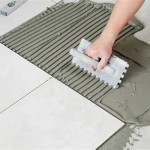Can Vinyl Plank Flooring Be Installed Over Tile?
Vinyl plank flooring offers a compelling combination of durability, affordability, and aesthetic appeal, making it a popular choice for homeowners. One common question that arises during renovation planning is whether vinyl plank flooring can be installed directly over existing tile. The answer, in most cases, is yes, but with some important caveats and considerations.
Assessing the Existing Tile
The condition of the existing tile is the primary factor in determining the feasibility of installing vinyl plank flooring over it. Loose or damaged tiles must be addressed before vinyl plank installation. Loose tiles should be re-adhered or replaced, while cracked or chipped tiles should be repaired or replaced to ensure a stable and level subfloor. Ignoring these issues will result in an uneven finished floor, potentially damaging the vinyl planks and compromising their longevity.
Grout lines also play a crucial role. Deep or wide grout lines can telegraph through the vinyl flooring over time, creating an uneven surface and potentially weakening the planks. For grout lines deeper than 1/8 inch, it is recommended to fill them with a leveling compound to create a smooth and even surface before installing the vinyl planks.
Cleanliness is another critical factor. The tile surface must be thoroughly cleaned and free of any debris, wax, or sealers that could interfere with the adhesion of the vinyl flooring or the underlayment. A clean subfloor is essential for optimal bonding and a long-lasting installation.
Choosing the Right Underlayment
Selecting the appropriate underlayment is paramount for a successful installation over tile. The underlayment performs several vital functions, including providing cushioning for comfort, reducing sound transmission, and acting as a moisture barrier. When installing over tile, a thinner underlayment is often preferred to minimize height discrepancies and maintain a smooth transition with adjacent flooring.
The type of vinyl plank flooring also influences the choice of underlayment. For click-lock vinyl planks, a thinner, denser underlayment is often recommended. For glue-down vinyl planks, a specific type of underlayment compatible with the adhesive may be required. Consulting the manufacturer's recommendations for both the vinyl flooring and the adhesive is crucial to ensure compatibility and optimal performance.
Addressing Moisture Concerns
Moisture can be a significant concern when installing any flooring over tile, especially in areas prone to humidity or spills, such as bathrooms and kitchens. A moisture barrier underlayment is highly recommended in these situations to prevent moisture from seeping through the tile and damaging the vinyl planks. This is especially important if the existing tile is installed over a concrete subfloor, which can be susceptible to moisture transmission.
Ensuring proper ventilation is also crucial in moisture-prone areas. Adequate ventilation helps to prevent moisture buildup and minimize the risk of mold and mildew growth. This can involve installing exhaust fans, dehumidifiers, or simply ensuring good airflow through open windows and doors.
Types of Vinyl Plank Flooring
Different types of vinyl plank flooring have specific installation requirements, and these must be considered when installing over tile. Click-lock vinyl planks are generally easier to install over tile, as they float over the subfloor and do not require adhesive. Glue-down vinyl planks, on the other hand, require a compatible adhesive and a perfectly smooth and level subfloor for proper adhesion.
The thickness of the vinyl plank also influences the installation process. Thicker planks are generally more durable and can better bridge minor imperfections in the subfloor, while thinner planks may require a more meticulously prepared surface.
Subfloor Preparation Techniques
Preparing the subfloor is critical for a successful installation. This may involve filling deep grout lines with a leveling compound, as mentioned earlier, or using a self-leveling underlayment to create a smooth and even surface. For minor imperfections, a thin underlayment may be sufficient. However, for significant unevenness, more extensive preparation work may be necessary.
It is important to ensure the subfloor is structurally sound and able to support the weight of the vinyl plank flooring and any furniture or appliances placed on it. If there are any concerns about the structural integrity of the subfloor, it is advisable to consult a professional contractor before proceeding with the installation.
Doorways and Transitions
Consider the height of the new flooring when installing over existing tile. The added height can affect doorways and transitions to other flooring materials. It may be necessary to undercut door jambs or use transition strips to create a smooth and even transition between different flooring heights. Careful planning and measurement are essential to avoid issues with door clearance and ensure a professional-looking finished product.

Installing Luxury Vinyl Over Existing Tiles Choices Flooring

New Vinyl Plank Flooring Over Tile Table And Hearth

Transform Your Home Installing Vinyl Flooring Over Ceramic Tiles City Wall And Floor

Can You Lay Vinyl Flooring Over Tile Mersey

How To Install Vinyl Plank Floors In A Bathroom Over Tile

Can You Put Vinyl Flooring Over Tile Igloo Surfaces

New Vinyl Plank Flooring Over Tile Table And Hearth

Can You Put Lvp Over Tile Wc Supply Whole Cabinet

Can You Put Vinyl Flooring Over Tile A Complete Guide Teka

New Vinyl Plank Flooring Over Tile Table And Hearth
Related Posts








